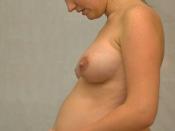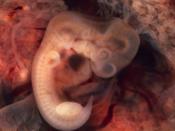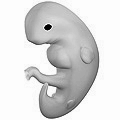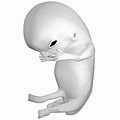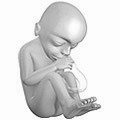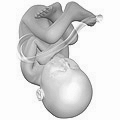IntroductionThe first three to six months of a womanÃÂs pregnancy is considered to be a critical period because during this period external stimuli can have a devastating affect on the development of the fetus. Since mother and child are interconnected and have a mutual relationship for the next nine months the fetus is very sensitive and at risk to whatever dangers the mother faces. The placenta not only provides nutrients and oxygen but it also provides protection from everything that could harm an unborn child. Teratogens are especially damaging in the embryonic stage because it is a critical period in prenatal development because this is when the ÃÂfoundations for all body parts are being laid downÃÂ (Berk, 2008, p.106). Teratogens can be easily classified into different categories which include prescription and non-prescription drugs, illegal drugs, alcohol, tobacco, infectious disease and environmental factors such as radiation and pollution that could potentially cause harm to an unborn child.
There are times when teratogens such as chemicals and viruses can reach the embryo or fetus during prenatal development and cause harm or interfere with the development sometimes causing birth defects or even a miscarriage but they are most ÃÂvulnerable to damage when they are developing most rapidlyÃÂ (Papalia, Olds, & Feldman, 2006, p.91) which generally occurs within the first trimester of pregnancy.
Article OverviewThe article I chose discussed the outcome of pregnancies after the fetus was exposed to lithium during the first trimester of pregnancy. According to Jacobson, Jones, etc., there are .1% of pregnant women that are estimated to use lithium, which is used in the ÃÂtreatment or prophylaxis of bipolar disorder or maniaÃÂ (Dictionary.com). The article discussed how in-utero exposure to lithium may be associated with ÃÂan increased risk of cardiac malformations, especially the rare EbsteinÃÂs anomalyÃÂ (Jacobson, Jones, & et al., 1992) which causes the ÃÂtricuspid valve of the heart to be abnormally formedÃÂ (American Heart Association, 2009) and increases the risk of heart failure. The study consisted of 148 women who had requested information from teratogen information services regarding the ÃÂpotential risks of therapeutic drugs during pregnancyÃÂ (Jacobson, Jones, & et al., 1992).
The women were interviewed by a doctor where they disclosed information about the drugs or other chemicals that were taken during pregnancy along with the ÃÂindication, dose, toxicity of the drug and its toxic effects, and monitoringÃÂ (Jacobson, Jones, & et al., 1992). The women also disclosed their medical, obstetric, and family history along with any occupational exposures which could cause complications to the fetus as well. Through the information that was obtained the pregnant women were offered advice on what to do as well as being referred to the appropriate person who could provide them with the appropriate treatment and care during their pregnancy. After the delivery of the baby, the mothers received a phone call from researchers where they were to disclose further details of their pregnancies including the ÃÂoutcome, perinatal complications, birth weight, physical findings, and developmental milestonesÃÂ (Jacobson, Jones, & et al., 1992) of the babies. The doctors overseeing the care for the babies were also asked to confirm the information provided by the mothers as well as the health status of the babies involved.
The research showed that some of the babies were affected by their motherÃÂs use of lithium causing congenital malformations, neural-tube defects, cerebral palsy, spina bifida, and premature deliveries which ended in death where others experienced no adverse affects from their motherÃÂs use of lithium.
Limitations and implications of the studyThe implications to the study implied that even though lithium is not a major human teratogen that there is a possibility for it to become hazardous to the fetus if too much is taken at a specific time during the development of the fetus. Even though the study suggested that women who take lithium are safe to conceive a baby there is evidence that does show that the use of lithium can be harmful to the unborn fetus. The risks may be greater for someone depending on ÃÂexposure and drug dosageÃÂ which are critical pieces of information that is needed in order to ÃÂassess any causal relation between any xenobiotic and outcomeÃÂ (Jacobson, Jones, & et al., 1992). However the evidence did suggest that malformations of the fetus are more susceptible during the time when the fetus is developing at a rapid rate but there is not enough evidence to suggest that the fetus will develop normally with no complications for motherÃÂs who do use lithium. The study did not include how they developed over time and if they experienced any mental or emotional delays during their development.
Conclusion critiqueThe study concluded that lithium is not considered to be a major human teratogen since ÃÂlithium has a very narrow therapeutic windowÃÂ (Jacobson, Jones, & et al., 1992) where toxic effects could occur. However they do believe that the ÃÂteratogenicity of lithium might be dose-relatedÃÂ (Jacobson, Jones, & et al., 1992). Since they are not sure whether or not the use of lithium is a teratogen there has to be long term effects that the child will experience because of this drug being in their system for such a long period of time over their development in their motherÃÂs womb. Since unborn babies depend on their mother for survival anything that could potentially cause birth defects or malformations should be only used after a doctor confirms no harm can come to the unborn child.
References:American Heart Association (2009). Retrieved August 22, 2009 fromhttp://www.americanheart.org/presenter.jhtml?identifier=11075Berk, L. (2008). Infants, children, and adolescents. (6th ed.). Boston: Pearson.
Jacobson, S. J., Jones, K, & et al. (1992). Prospective Multicentre Study of PregnancyOutcome after Lithium Exposure during First Trimester. TheLancet, 339(8792), 530. Retrieved August 21, 2009, from Research Library.
(Document ID: 1694906).
lithium. (n.d.). Dictionary.com Unabridged (v 1.1). Retrieved August 23, 2009, fromDictionary.com website: http://dictionary.reference.com/browse/lithiumPapalia, D, Olds, S, & Feldman, R. (2006). A ChildÃÂs World: Infancy throughAdolescence. New York: McGraw-Hill
